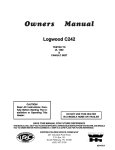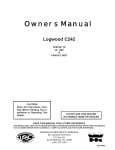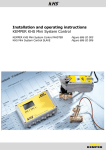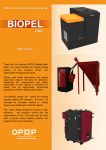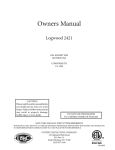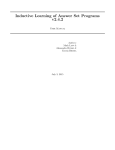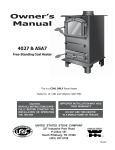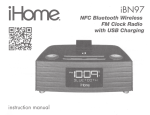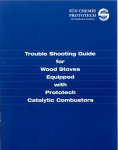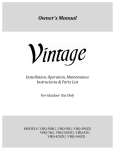Download United States Stove C242 Operating instructions
Transcript
gwood
TESTED TO
UL 1482
&
CAN/ULC S627
CAUTION!
Read All Instructions Carefully Before Starting The installation or Operating This
Heater.
DO NOT USE THIS HEATER
IN A MOBILE HOME OR TRAILER
SAVE THIS MANUAL FOR FUTURE REFERENCE
THIS MANUAL WILL HELP YOU TO OBTAIN EFFICIENT, DEPENDABLE SERVICE FROM THE HEATER, AND ENABLE
YOU TO ORDER REPAIR PARTS CORRECTLY. KEEP IN A SAFE PLACE FOR FUTURE REFERENCE.
UNITED STATES STOVE COMPANY
227 Industrial Park Road
P.O. Box 151
South Pittsburg, TN 37380
(423) 837-2100
851476C
co
!
You've purchased a heater from North America's oldest manufacturer of wood burning
products.
wood you're helping to
ERGY!
Wood is our only Renewable Energy Resource. Please do your part to preserve our wood
supply. Plant at least one tree each year. Future generations will thank you.
Tools and Materials Needed
MATERIALS
6" Elbow, Collar and Thimble: As Required
(24 gauge min.)
1/2" Sheet Metal Screws (No. 10A x 1/2")
6" Diameter, 24 gauge, black or blued steel
Underwriters Laboratories (UL,ULC) Listed
Residential Type HT (2100°F) Chimney or use a
Masonry Chimney in goor repair.
Floor Protector Material (R value = 2.0) Minimum of
3'-0" x 4'-6" for US Standard or a Minimum of 2'-3
4" x 4'-11" for Canadian Standard Installation As
specified On Page 4
Furnace Cement {Manufacturer Recommends:
Rutland Black Code 78 or Equivalent}
6" Barometric Draft Regulator (DR-6)
TOOLS
Pencil
6 Foot Folding Rule or Tape Measure
Tin Snips
Hand or Electric
Drill Bit 1/8" Dia. (For Sheet Metal Screws)
Adjustable Wrench
Screw Driver (Blade-Type)
Gloves
Safety Glasses
HEATER DIMENSIONS
FIG. 1
38"
~
31"
..,
,... 5-1/4"
16"
--
--
28"
\
9-3/8"
"
FLOOR PROTECTOR
2
~
25"
Safety Rules
SAFETY NOTICE: If this heater is not properly installed a house fire may result. For your safety, follow the
installation directions. Contact local building or fire officials about restrictions and installation inspection
requirements in your area.
Read these rules and the instructions
9.
For fut1her information on using your heater
safely, obtain a copy of the National Fire Protection Association (NFPA)
Coal and Wood Stoves Safely" NFPA No. HS10-1978. The address of the NFPA is
Batterymarch Park, MA 02269.
For more information on a Canadian Installaobtain a copy of CAN/CSA - B365 - M91
Installation Code for Solid-Fuel-Burning Appliances and Equipment.
Do not connect a wood burning heater to a Type
B gas vent. This is not safe and is prohibited by
the National Fire Protection Association Code.
This heater requires approved masonry or ULI
UlC Listed Residential Type and Building HeatAppliance Chimney. Use a 6" diameter chimney or larger, that is high enough to give a good
draft.
10.
Disposal of Ashes- Place ashes in a metal
container with a tight fitting lid. Keep the closed
container on a non-combustible floor or on the
ground, well away from all cornbustible materials. Keep tile ashes in the closed container
until all cinders have thoroughly cooled. The
ashes may be buried in the ground or picked up
by a refuse collector.
Be sure that your chimney is safely constructed
and in good repair. Have the chimney inspected
by the Fire Department or a qualified inspector.
Your insurance company may be able to recommend a qualified inspector.
11.
CAUTION- The special paints used on your
heater may give off some smoke while they are
curing during the first few fires. Build small fires
at first.
12.
CARING FOR PAINTED PARTS- This heater
has a painted jacket, which is durable but it will
not stand rough handling or abuse. When
installing your heater, use care in handling.
Clean with soap and warm water when heater
is not hot. DO NOT use any acids or scouring
soap, as tl1ese wear and dull the finish. PAINT
DISCOLORATION Will OCCUR IF THE
HEATER IS OVERFIRED. FOllOW OPERATING INSTRUCTIONS CAREFUllY.
13.
All persons, especially children, should be
alerted to hazards from high surface temperatures and kept away while in operation. Small
children should not be left unsupervised when
in the room with the heater.
14.
Keep the area adjacent to the heater free from
all combustible materials, gasoline, and other
flammable vapors.
1.
Check with local codes. The installation
with their rulings. Observe closely the clearances
to combustibles (page
2.
Do not install this heater in a mobile home or
trailer.
3.
Always connect this heater to a chimney and vent
to the outside. Never vent to another room or
inside a building.
4.
5.
6.
Inspect chimney connector and chimney twice
during the heating season for any deposit of creosote or soot which must be removed
(see Chimney Maintenance, page 9).
7.
Provide air for combustion from outside the house
into the room where the heater is located. If the
intake is not in the same room, air must have free
access in to the room.
8.
To prevent injury, do not allow anyone to use this
heater who is unfamiliar with the correct operation of the heater.
CAUTION! Do not touch the heater until it has cooled.
NOTE:
FOR YOUR SAFETY, WE RECOMMEND INSTALLING SMOKE DETECTORS IN YOUR HOME IF NOT
ALREADY INSTALLED.
3
MINIMUM CLEARANCE
TO COMBUSTIBLE WALLS
US ,CANADA
Install
Place tile heater on solid masonry or solid concrete. When
the heater is used on a combustible floor, use an Underwriters Listed floor protector. The floor protector must comply
with UL Standards(USA) and CAN/ULC S627(Canada).The
base should extend at least 16"
the clool of the
heater and Sllould extend under Ule flue
il it is elbowed
towards a wall
5).
1.
2.
3.
4.
5.
6.
7.
8.
g.
10.
11.
12.
13.
8"
458mm
,
(60" MIN.)
Uncrate and/or unpack the heater, removing all packing material, being careful not to dispose of the Parts
Bag.
Open the front feed door and remove the parts from
inside the stove. You should find the following: Hearth
Plate (1); Solid Damper(1); Lids
Pivoting Top (1):
Lid SuppOl1 (1); Parts Package (1) containg nuts,
bolts, door handle, door latch and securing
Legs (4); Cast Iron Collar (1): Cast Iron Damper (1);
Baffle Assembly (1); Lid Lifter (1).
Place cardboard or other soft material adjacent
stove and carefully turn the stove onto its top side
(bottom facing
Attach hearth plate to the front of the stove in its proper
location.
Attach both rear and front
to the stove. Tighten
the nuts and bolts securely. The stove may now be
CAREFULLY turned over to stand on its four legs.
Attach the baffle assembly and flue collar to the stove
by inserting the baffle studs thru the two holes located
on the top of the rear of the stove; place the flue collar
over the studs and mount using the proper nuts and
washers. Place lid support and lid in position on
pivoting top. Place the slide damper in position on the
top of the hearth plate and under the feed door, and
secure with screw in slot.
After consulting the installation instructions for minimum clearances to combustibles, locate your floor
protector accordingly and carefully place the stove in
your selected location. Install stove pipe, elbows and
thimble as necessary, utilizing either a recently cleaned
and inspected masonry chimney (properly
ULIULC Listed chimney. Insure that the
provided is installed in the flue collar.
Again, check the following illustrations and be sure
you have the clearances shown from the heater and
the connector pipe to combustible surfaces. If you
have a solid brick or stone wall behind your heater,
you may place your heater as close as you wish to the
wall. However, if the wall is only faced with brick or
stone, consider it a combustible wall.
If your chimney drafts excessively, purchase and use
a Barometric Draft Regulator (DR6 available from
factory).
The chimney connection should be as short as possible, and the heater must have its own flue. Do not
connect this unit to a chimney flue serving other
appliances.
Use three sheet metal screws in each stove pipe and
or elbow joint to firmly hold the pipe together.
Do not install this heater in a mobile home or trailer.
Check your local building and insurance codes. The
installation must comply with their rulings.
-
-
37·112"953mm
28" 712mm
-::
34"
855mm
26" 660mm
/
_ 20" L
508mm
_ 28"L
712mm
HEATERIFLOOR PROTECTOR LOCATION
(Dimensions are required for non-protected surfaces.
See chart for dimensions for protected surfaces.)
BACK WALL
DASHEDUNES
SHOW STRAIGHT
OUT CHIMNEY
CONNECTOR
NON· COMBUSTIBLE
CONSTRUCTION IN
ACCORDANCE WITH
NFPA 211 or CAN/CSA
B365·M91
34"
865mm
730mm
8"
200mm
1
I
50"
FLOOR
PHOTECTOR
18"
450mm
FIG. 4
1
8 '1
"~
.....
:-I
200mm
8 11
200mm
~
28"
204mm
-i
Protected Surfaces
12-inches
305-mm
12-inches
305-mm
+ 12-incbt3s
305-mm
CAUTION!
KEEP FURNISHINGS AND OTHER
COMBUSTIBLE MATERIALS
AWAY FROM THE HEATER.
4
Operation of
1.
2.
3.
4.
5.
6.
7.
8.
Heater
BE SURE TO PUT A LAYER OF SAND OR FIREBRICK
APPROXIMATELY 1 1/2" THICK IN THE BOTTOM OF THE
STOVE BEFORE STARTING FIRE.
Burn wood or wood products only. The wood Sllould be air
dried for at least six montlls orior to use for maximum effiAfter the fire has been started and is burning satisfactorily,
adjust the rate of burning by opening or closing the draft
damper wheel on the feed door.
Never build extremely large fires in this type of heater as
damage to the heater or smoking may result.
Provide air into the room for combustion.
Do Not touch the heater after firing until it has cooled.
Do Not use a grate or elevate fire, build fire directlv on hearth.
The fuel feed door must remain closed during
FLUE CONNECTION-NON-COMBUSTIBLE WALL
NON-COMBUSTIBLE WALL
THIMBLE
COLLAR
BOW
'" "
"
BAROMETRIC
DRAFT REGULATOR
PIPE
FIG. 5
Chi ney Connection
MASONRY CHIMNEY
The masonry chimney must comply with ULIULC codes. Before
FLOOR REGULATOR
using an existing masonry chimney, clean the chimney and inspect
the flue liner to be sure it is safe to use. Make repairs before ....
' _ _ _ _ _ _ _ _ _ _ _ _ _ _ _ _ _ _---'
attaching the heater. See Page 3, Item 5. Look at Fig. 6. The
connector pipe and fittings you will need to connect directly to a
CHIMNEY CAP MANDATORY
masonry chimney are shown. If the connector pipe must go
through a combustible wall before entering the masonry chimney,
consult a qualified masonor chimney dealer. The installation must
.,
2 FT. MIN
conform to local fire codes. Do not connect this heater into the
- 3 FT. MIN.
I 10 FT.
same chimney flue as the fireplace or flue from another heater.
The chimney used for a heater must not be used to ventilate the
cellar or basement. If there is a cleanout opening at the base of the
chimney, close it
,
UL LISTED CHIMNEY
Carefully follow chimney manufacturer's instructions. Use only listed
type HT per UL 103, or ULC 8629, 6-in diameter black or blued
connector, minimum 24 gauge steel. If your chimney starts at the
ceiling (Fig. 7), you will need enough 6" pipe to reach the ceiling.
The top of the chimney must be at least 3 feet above the roof and be
at least 2 feet higher than any pOint of the roof within 10 feet. (Fig 6)
PIPE REDUCER
11 FT. MINIMUM
NON-COMBUSTIBLE
CONSTRUCTON IN
ACCORDANCE WITH
NFPA 211(USAl or
RULES FOR CONNECTOR PIPE INSTALLATION
1.
2.
3.
4.
5.
6.
7.
Crimped end of the pipe must be installed toward the heater.
The pipe should slide into the flue collar. The pipe should be
firmly attached to the flue coliar with 3 screws and sealed with
furnace cement.
Slope any horizontal pipe upward toward the chimney at least
1/4 II inch for each foot of horizontal run.
You must have at least 18" inches clearance between any
horizontal piping and the ceiling. (Fig. 4)
The pipe cannot extend into the chimney flue.(Fig. 8}
Seal each connector pipe joint with furnace cement. Also seal
the pipe at the chimney.
Use 3 sheet metal screws at each joint to make the piping
It is recommended that no more than two (2) 90 degree bends
be used in the stove pipe installation as more than two (2) may
decrease the amount of draw and possibly cause smoke
spillage.
NOTE: The chimney connector shall not pass through an
attic, roof space, floor, ceiling, or similar concealed space.
Where passage through a wall or partition of combustible
construction is desired, the installation must conform with
CAN/CSA - 6365.
5
FIG. 6
./
FLOOR PROTECTOR
FIG. 7
CONNECTION OF CHIMNEY CONNECTOR TO A MASONRY CHIMNEY THROUGH A COMBUSTIBLE WALL
connector of a heater to a masonry chimney
Figure 8 shows how to connect the
There are five allowable ways that a
connector can be connected to a masonry
a combustible wall. NFPA Standard 211 allows tile following wall pass-through
a combustible wall.
passing
FIGURE 8CONNECTION OF CHIMNEY CONNECTOR TO A
MASONRY CHIMNEY THROUGH A COMBUSTIBLE
WALL
w
~
....J
u...
>w
Z
2
I
o
CEILING
SEE PARTS A, B,
C, D, AND E OF
THIS FIGURE FOR
OPTIONS.
CHIMNEY CONNECTOR
MASONRY CHIMNEY
CONSTRUCTED TO
NFPA211
TO
HEATER
,
I
COMBUSTIBLE WALL
FLOOR
PROTECTOR
AIRTIGHT
CLEANOUT
DOOR
(FIGURE 8 CONTINUED ON NEXT PAGE)
6
PART A, FIGURE 8
(FIGURE 5 CONTIUED ON NEXT PAGE)
MINIMUM CHIMNEY CLEARANCE TO
BRICK AND COMBUSTIBLES IS 2 IN,
MINIMUM CLEARANCES 121N.
OF BRICK ALL AROUND
W
::J
...J
LL
>-
Ll!
Z
2
MiNiMUM 12 iN,
TO COMBUSTiBLES ,
I
o
MASONRY CHIMNEY
CONSTRUCTED TO
NFPA211
CHINEY COr~NECI (JR TO
HEATER
FIRECLAY liNER
(5/8" MIN, WALL THICKNESS)
MIN, 3-1/2"THICK BRICK
MASONRY WALL
1,
Use a minimum 3-1/2" thick brick masonry wall framed into the combustible wall. A fireclay liner (ASTM C315 or
equivalent) having a 5/8" minimum wall thickness must be used and it must be at least 12" away from any material
that could catch fire. The inside diameter of the fireclay liner shall be sized for the proper snug fit of a 6" diameter
chimney connector pipe. The fireclay liner shall run from the outer surface of the brick wall to, but not beyond, the
inner surface of the chimney flue and shall be firmly cemented in place. See Part A of Figure 8.
2. Use a solid insulated listed factory-built chimney length having an inside diameter of 6" and having ill or more of
solid insulation. There must be at least a 9" air space between the outer wall of the chimney length and any
combustible materials. The inner end of the chimney length shall be flush with the inside of the masonry chimney
flue shall be sealed to the flue and to the brick masonry penetration with nonwater-soluble refractory cement. Sheet
steel supports which are at least 24 gauge(0,024") in thickness shall be securely fastened to wall
surfaces on all sides. Fasteners between supports and the chimney length shall not penetrate the chimney liner.
See Part B of Figure 8.
3. Use a 1011 diameter ventilated thimble made of at least 24 gauge(0.024") steel having two 1" air channels. The ventilated thimble must be separated from combustible materials by a minimum of 6" glass fiber insulation. The opening
in the combustible wall shall be covered and the thimble supported with sheet steel supports which are at least 24
gauge (0.024") in thickness, The sheet steel supports shall be securely fastened to wall surfaces on all sides and
shall be sized to fit and hold the chimney section. Fasteners used to secure chimney sections shall not penetrate
chimney flue liner. See Part C of Figure 8.
4. Use an 8" inside diameter solid insulated listed factory-built chimney length which has 1" or more of solid insulation.
The minimum length of this chimney section shall be 12" and will serve as a pass-through for the 6" diameter
chimney connector. There must be at least a 12" air space between the outer wall of the chimney section and any
combustible materials. The chimney section shall be concentric with and spaced 1" away from the chimney connec
tor by means of sheet steel support plates on both ends of the chimney section. The opening in the combustible wall
shall be covered and the chimney section supported on both sides with sheet steel supports which are at least 24
gauge (0.024") in thickness. The sheet steel supports shall be securely fastened to wall surfaces on all sides and
shall be sized to fit and hold the chimney section. Fasteners used to secure chimney sections shall not penetrate
chimney flue liner. See Part C of Figure 8.
5. A listed factory-built wall pass-through system may be purchased and installed according to the instructions pack
aged with it to provide a safe method of passing the chimney connector through a combustible wall for connection
to a masonry chimney,
Additional requirements pertaining to Figure 8 and the above wall pass-through systems:
1.
Insulation material used as part of wall pass-through system shall be of noncombustible material and shall have a
thermal conductivity of 1.0 Btu' in.lft.2 • OF (4.88 kg • cal/hr • m2 • 0c) or less
2. All clearances and thicknesses are minimums: larger clearances and thickness are acceptable.
3. A chimney thimble, as shown for 3" and 4" above (Parts C and D respectively of Figure 8) shall be for types "3" and
4" connections to facilitate removal of the chimney connector for cleaning. The chimney thimble shall be of ASTM
C315 fireclay with 5/8" minimum wall thickness, or material or equivalent durability. The inside diameter of the
thimble shall be sized for the proper snug fit of a 6" diameter chimney connector pipe. The thimble shall be installed
without damage to the chimney flue. The thimble shall extend through the chimney wall to, but not beyond, the
inner surface of the chimney flue and shall be permanently cemented in place with high temperature cement.
4. A chimney connector to a masonry chimney, except for 2" above (Part B of Figure 8), shall extend through the wall
pass-through system to the inner face of the chimney flue, but not beyond. It does not have to be fastened in place
so long as it cannot aCCidently be pulled out of the chimney or shoved into the chimney flue. If fasteners are used
to secure the chimney connector to a masonry chimney, the fasteners shall not penetrate the chimney flue liner.
5. Any material used to close up any opening for the connector shall be noncombustible.
7
B
URESFIGURE S CONTINUED)
MI"IMUM CHIMI~EY CLEARANCES FROM MASONRY TO
SHEET STEEL SUPPORTS AND COMBUSTIBLES 2 Ihl
ill
:3
u.
u'}
1)
LEI,IGHT
NOi'JSOLUBLE
REFACTORY
'Et;T
~
t';
l111~11,'iUl1
9 II, !\Ll
m
CHIMNEY CONNECTOR
HI:.II.TER
,-
CHII\~NEY
AIR SPACE
9 IN. MINIMUM
LEI"GHT
FLUSH WITI'I INSIDE
OF FLUE
USE CHIMNEY MFRS. PARTS TO
AIT ACH CONNECTOR SECURELY
SOLID INSULATED. LISTED
FACTORY-BUILT CHIMNEY LENGHT
MASONRY CHIMNEY CONSTRUCTED
TONFPA211
PARTC
FIGURES
SHEET STEEL SUPPORTS
(24 GAUGE MIN. THICKNESS)
CHIMNEY CLEARANCES FROM MASONRY TO
SHEET STEEL SUPPORTS AND COMBUSTIBLES 2 IN
24 GAUGE
VENTILATED THIMBLE WITH
TWO 1 INCH AIR CHANNELS
CHIMNEY THIMBLE
CHIMNEY CONNECTOR
TO HEATER
TWO VENTILATED AIR
CHANNELS EACH 1 INCH.
CONSTRUCED OF
SHEET STEEL.
MINIMUM 6 IN. GLASS
FIBER INSULATION ALL AROUND
SHEET STEEL SUPPORTS
(24 GAUGE MIN. THICKNESS)
MASONRY CHIMNEY
TONFPA211
MINIMUM CHIMNEY CLEARANCES FROM MASONRY TO
SHEET STEEL SUPPORTS AND COMBUSTIBLES 2 IN.
PARTD
FIGURES
r"
SHEET STEEL SUPPORTS
MINIMUM CLEARANCE
2 IN. ALL AROUND
CHIMNEY SECTION
CHIMNEY THIMBLE \,
·
I
" '..,__.:::1-
CHIMNEY
CONNECTOR
ill
::J
-'
ll_
1 IN. AIR SPACE TO
CHIMNEY LENGHT
CHIMNEY CONNECTOR
TO HEATER
>-
ill
Z
-_.>
'~;i'--~'1
,~LII._m..J;;:;;;~;:''';::':~L';;,::;/i
:2!
----AIRSPACE
I
u
2
MASONRY CHIMNEY CONSTRUCTED
TONFPA211
SHEET STEEL SUPPORTS
(24 GAUGE MIN. THICKNESS)
PART E - (Figure 8)
In addition to the methods shown by A, B, C, and D of Figure 8, a listed factory-built wall pass-through system
may be purchased and installed according to the instructions packaged with it to provide a safe method of
passing chimney connector through a combustible wall for a connection to a masonry chimney.
CONNECTION OF CHIMNEY CONNECTOR TO A MASONRY CHIMNEY WHEN CHINEY CONNECTOR
DOES NOT PASS THROUGH A COMBUSTIBLE WALL
If the chimney connector does not have to pass through a combustible wall to get to a masonry chimney, simply connect
the chimney connector directly to the masonry chimney's chimney thimble as described and shown by parts C and D of
Figure 8. Remember, the chimney connector should extend into the chimney thimble to the innerface of the chimney flue
but not beyond; if the chimnney connector is extended through the chimney thimble into the chimney flue, resistance to
the flow of smoke and gases up the chimney will occur; that flow resistance will have an adverse affect on the rmor",tirm
and performance of the heater and venting system.
8
WARNING!
NEVER STORE FLAMMABLE LIQUIDS,
ESPECIALLY GASOLINE. IN THE
VICINITY OF THE HEATER.
CAUTION!
NEVER USE GASOLINE, GASOLINE-TYPE
LANTERN FUEL, KEROSENE, CHARCOAL
LIGHTER FLUID, OR FLAMMABLE
LIQUIDS TO START OR "FRESHEN UP" A
FIRE IN THE HEATER.
CAUTION!
OVERFIRING THE APPLIANCE MAY
CAUSE A HOUSE FIRE. IF A UNIT OR
CHIMNEY CONNECTOR GLOWS, YOU
ARE OVERFIRING.
CAUTION!
USE WOOD OR WOOD-LIKE MATERIALS
ONLY. DO NOT USE COAL OR
CHARCOAL COAL OR CHARCOAL WILL
DESTROY THE FIREBOX. DO NOT USE
DRIED LUMBER OR TREATED WOOD.
WARNING!
NEVER OPERATE THIS HEATER WITH THE
FUEL DOOR OPEN.
NOTE:
DO NOT ELEVATE FIRE OR USE WITH A
GRATE - BUILD FIRE DIRECTLY ON THE
HEARTH.
WARNING!
USE ONLY THE LEGS PROVIDED WITH THIS
HEATER. REFER TO STEP 5 IN THE "INSTAlLATION" SECTION OF THIS MANUAL
Service
WARNING!
DO NOT OBSTRUCT THE SPACE BENEATH
THE HEATER
ints
Do not expect a heater to draw. It is the chimney that creates
the draft. Smoke spillage into the house or excessive buildup
of water or creosote in the chimney are warnings that the
chimney is not functioning properly. Correct problem before
using heater. Possible causes are:
1.
The connector pipe may pushec into the chimney too far,
stopping the draft. (Fig. 7)
2.
Do not connect two heaters into the same chimney flue.
3.
The chimney used for a heater must not be used to
ventilate the cellar or basement. If there is a cleanout
opening at the base of the chimney, It must be closed
tightly.
4.
If the chimney is operating too cool, water will condense
in the chimney and run back into the stove. Creosote
formation wi! be rapid and may block the chimney.
Operate the heater at a high enough fire to keep the
chimney warm preventing this condensation.
5.
If the fire burns well but sometimes smokes or burns
slowly, it may be caused by the chimney top being lower
than another part of the house or a nearby tree. The wind
blowing over a house or tree, falls on top of the chimney
like water over a dam, beating down the smoke. The
of the chimney should be at least 3 feet above the roof
and be at least to 2 feet higller than any point of the roof
within 10 feet (Fig. 6).
Chimney Maintenance
Creosote - Formation and Need for Removal
If creosote has accumulated, it should be removed. Failure to
remove creosote may cause a house fire. Creosote may be
removed by using a chimney brush or other commonly
available materials.
When wood is burned slowly, it produces tar and other
organic vapors, which combine with expelled moisture to
form creosote. The creosote vapors condense in the relatively cool chimney flue of a slow burning fire. As a result,
creosote residue accumulates on the flue lining. When ignited this creosote makes an extremely hot fire.
Chimney fires burn very hot. If the chimney connector should
glow red, immediately call the fire department, then reduce
the fire by closing the inlet air control and pour a large quantity
of coarse salt, baking soda or cool ashes on top of the fire in
the firebox. CAUTION: A chimney fire may cause ignition of
wall studs or rafters which you thought were a safe distance
from the chimney. If you have a chimney fire, have your
chimney inspected by a qualified person before using again.
The chimney connector and chimney should be inspected at
least twice monthly during the heating season to determine
if a creosote buildup has occurred.
9
14
I C242
Repai r Parts
19
15
12
11
10
20
22
23
8
5
16
17
1
13
7
KEY
PART NO.
DESCRIPTION
QNTY.
1
2
3
4
5
6
7
8
9
10
11
12
13
14
15
16
17
18
19
20
21
40319
40319
40320
40321
40322
40323
40324
40325
40326
40327
40329
40330
40331
40332
D6
83427
40334
69307
89974
89975
89971
89972
89973
REAR LEG
FRONT LEG
MAIN BOTTOM
MAIN SIDE
MAIN BACK
HEARTH PLATE
SLIDING DRAFT PLATE
DOOR FRAME
DOOR
MAINTOP
LID
LID SUPPORT
LID LIFTER
FLUE COLLAR
SOLID FLUE DAMPER
DOOR PINS
DRAFT CONTROL KNOB
BAFFLE ASSEMBLY
HANDLE EXTENSION
HANDLE BRACKET
HANDLE
LATCH
NUTS
OWNERS MANUAL
2
2
1
2
1
1
1
1
1
1
2
1
1
1
1
2
1
1
1
1
1
1
3
1
22
23
* ,~1476
'--
_._--
* NOT SHOWN
10
....
......
00
r=
-<
00
s:
m
(lJ
or=
r=
»
:u
»(lJ
o
z
o
»
""r=m
»
ow
o D
PAIR
THIS MANUAL WILL HELP YOU OBTAIN EFFICIENT, DEPENDABLE SERVICE FROM
THE HEATER, AND ENABLE YOU TO ORDER REPAIR PARTS CORRECTLY.
KEEP IN
SAFE PLACE FOR FUTURE REFERENCE.
WHEN WRITING, ALWAYS GIVE
FULL MODEL NUMBER WHICH IS ON THE
NAMEPLATE ATTACHED
THE BACK OF THE HEATER.
ORDERING REPAIR PARTS, ALWAYS GIVE THE
FOLLOWING INFORMATION AS SHOWN IN THIS LIST:
1. The PART NUMBER
2. The PART DESCRIPTION
3. The MODEL NUMBER: C242
4. The SERIAL NUMBER:
UNITED STATES STOVE COMPANY
227 Industrial Park Road
P.O. Box 151
South Pittsburg, TN 37380
(423) 837-2100
www.USSTOVE.com












